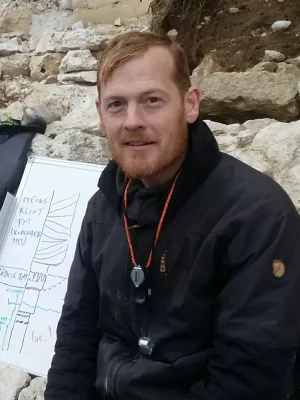
Mikael Calner
Professor

Carbonate platform evolution and conodont stratigraphy during the middle Silurian Mulde Event, Gotland, Sweden
Författare
Summary, in English
Evidence from sedimentology and conodont biostratigraphy is used to reinterpret the mid-Homerian (Late Wenlock) succession on Gotland, Sweden. A new conodont zonation includes from below: the Ozarkodina bohemica longa Zone (including five subzones), the Kockelella ortus absidata Zone and the Ctenognathodus murchisoni Zone (two taxa are named, Ozarkodina bohemica longa and Pseudooneotodus linguicornis). These new zones are integrated with facies in order to correlate strata and infer the major depositional environments and the controls on deposition during the mid-Homerian Mulde Event. Reef-associated and skeletal carbonate deposition predominated before and after the event, i.e. during the uppermost O. s. sagitta Zone and, again, in the C. murchisoni Zone. These periods are characterized by the expansion of reefs and shoal facies across marls in the topmost Slite Group on eastern Gotland and in the lower parts of the Klinteberg Formation on western Gotland, respectively. The intervening O. b. longa and K. o. absidata zones are initially characterized by rapid facies changes, including siliciclastic deposition, and later stabilisation of a carbonate depositional system. The composition of sediments and depositional rates are closely related to the creation and destruction of accommodation space and reflects a classical case of depositional bias of the carbonate and siliciclastic depositional systems. Based on coastline migration, stratal boundaries, and the stratigraphic position of major reef belts, several facies associations can be fitted into a sequence stratigraphic model for platform evolution. A highstand systems tract (HST) situation prevailed prior to, and during the early part of the event; the upper Slite Group including the lower Frjel Formation. This HST was characterized by prolific skeletal production and regional reef development except for during the latest stage when carbonate production declined at the onset of the Mulde Event. Platform growth was inhibited during a following regressive systems tract (RST) when regional siliciclastic deposition predominated; the Gannarve Member. The subsequent lowstand resulted in regional emersion and karstification, i.e. a complete termination of the platform. The post-extinction transgressive systems tract (TST) is exclusively composed of non-skeletal carbonates; the Bara Member of the Halla Formation. Re-occurrence of reefs and a prolific skeletal production marks platform recovery during a second HST; the remaining Halla and the lower Klinteberg formations. Integration of high-resolution biostratigraphy and sequence stratigraphy reveals that the major physical control on platform evolution was a 5th order eustatic sea-level change during an early part of the Mulde Event, and that the bulk of the strata accumulated when the platform aggraded and prograded during the highstand systems tracts. Thus, Silurian oceanic events and associated sea-level changes had profound impact on the neritic carbonate system. The Gotland-based middle and late Homerian sea-level curve shows two rapid regressions, both leading to truncation of highstand systems tracts. The first lowstand occurred at the very end of the C. lundgreni Chron, and the second at the end of the Co.? ludensis Chron. The intervening interval was characterized by stillstand or possibly slow transgression.
Avdelning/ar
- Berggrundsgeologi
Publiceringsår
2003
Språk
Engelska
Sidor
173-203
Publikation/Tidskrift/Serie
Geological Magazine
Volym
140
Issue
2
Fulltext
Dokumenttyp
Artikel i tidskrift
Förlag
Cambridge University Press
Ämne
- Geology
Status
Published
ISBN/ISSN/Övrigt
- ISSN: 0016-7568

